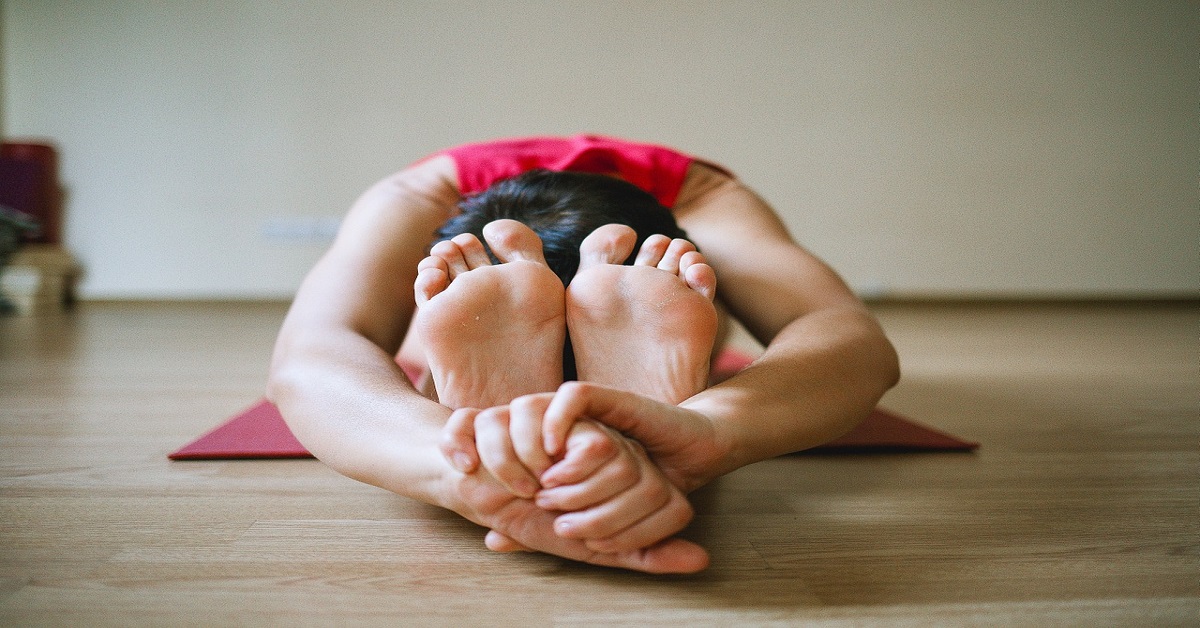
This yoga pose is both simple yet challenging. Here it is.
Corpse Pose
Savasana is a pose of total relaxation—making it one of the most challenging.
(shah-VAHS-anna)
sava = corpse
This pose is also called Mrtasana (pronounced mrit-TAHS-anna, mrta = death)
Corpse Pose: Step-by-Step Instructions
Step 1
In Savasana, it’s essential that the body be placed in a neutral position. Sit on the floor with your knees bent, feet on the floor, and lean back onto your forearms. Lift your pelvis slightly off the floor and, with your hands, push the back of the pelvis toward the tailbone, then return the pelvis to the floor. Inhale and slowly extend the right leg, then the left, pushing through the heels. Release both legs, softening the groins, and see that the legs are angled evenly relative to the mid-line of the torso and that the feet turn out equally. Narrow the front pelvis and soften (but don’t flatten) the lower back.
Step 2
With your hands lift the base of the skull away from the back of the neck and release the back of the neck down toward the tailbone. If you have any difficulty doing this, support the back of the head and neck on a folded blanket. Broaden the base of the skull too, and lift the crease of the neck diagonally into the center of the head. Make sure your ears are equidistant from your shoulders.
Step 3
Reach your arms toward the ceiling, perpendicular to the floor. Rock slightly from side to side and broaden the back ribs and the shoulder blades away from the spine. Then release the arms to the floor, angled evenly relative to the mid-line of the torso. Turn the arms outward and stretch them away from the space between the shoulder blades. Rest the backs of the hands on the floor as close as you comfortably can to the index finger knuckles. Make sure the shoulder blades are resting evenly on the floor. Imagine the lower tips of the shoulder blades are lifting diagonally into your back toward the top of the sternum. From here, spread the collarbones.
Step 4
In addition to quieting the physical body in Savasana, it’s also necessary to pacify the sense organs. Soften the root of the tongue, the wings of the nose, the channels of the inner ears, and the skin of the forehead, especially around the bridge of the nose between the eyebrows. Let the eyes sink to the back of the head, then turn them down to gaze at the heart. Release your brain to the back of the head.
Step 5
Stay in this pose for 5 minutes for every 30 minutes of practice. To exit, first roll gently with an exhalation onto one side, preferably the right. Take 2 or 3 breaths. With another exhalation press your hands against the floor and lift your torso, dragging your head slowly after. The head should always come up last.
READ ALSO: Yoga: a healthy way to a healthy life
Pose Information
Sanskrit Name
Savasana
Pose Level: 1
Contraindications and Cautions
Back injury or discomfort: Do this pose with your knees bent and your feet on the floor, hip-distance apart; either bind the thighs parallel to each other with a strap (taking care not to position the heels too close to the buttocks) or support the bent knees on a bolster.
Pregnancy: Raise your head and chest on a bolster.
Modifications and Props
Usually, Savasana is performed with the legs turned out. Sometimes though, after a practice session involving lots of outward rotation of the legs (as for standing poses), it feels good to do this pose with the legs turned in. Take a strap and make a small loop. Sit on the floor with your knees slightly bent and slip the loop over your big toes. Lie back and turn your thighs inward, sliding your heels apart. The loop will help maintain the inward turn of the legs.
Deepen the Pose
To help release the brain and quiet the mind in Savasana, take a block and a 10-pound sandbag. After reclining on the floor, position the block on the floor above your head. The block should sit on one of its sides (the height of the block should be about 5 inches), with one of its ends lightly touching your crown. Then lay the sandbag half on the block and half on your forehead. Scrub the forehead skin down, toward your eyebrows. Then let the brain sink away from this weight.
Preparatory Poses
Savasana should conclude both your asana and your pranayama practices.
Beginner’s Tip
Often it’s difficult to release the heads of the thigh bones and soften the groins in this pose. This creates tension throughout the body and restricts the breath. Take two 10-pound sandbags and lay one across each top thigh, parallel to the crease of the groin. Then imagine that the heads of the thigh bones are sinking away from the weight, down into the floor.
Benefits
Calms the brain and helps relieve stress and mild depression
Relaxes the body
Reduces headache, fatigue, and insomnia
Helps to lower blood pressure
Partnering
In Savasana, it’s especially useful to have a partner check your physical alignment. One of the most difficult parts of the body to align on your own is your head. Have your partner sit at your head and observe its position relative to your shoulders. It’s common for students’ heads to be tilted or turned to one side or the other. The partner should gently cradle your head in his/her hands and draw the base of the skull away from the back of the neck, lengthening the shorter side of the neck, so that both ears are equidistant from the shoulders. Then your partner can lay your head back down on the floor, making sure that the tip of your nose is pointing directly toward the ceiling.

Post Your Comments